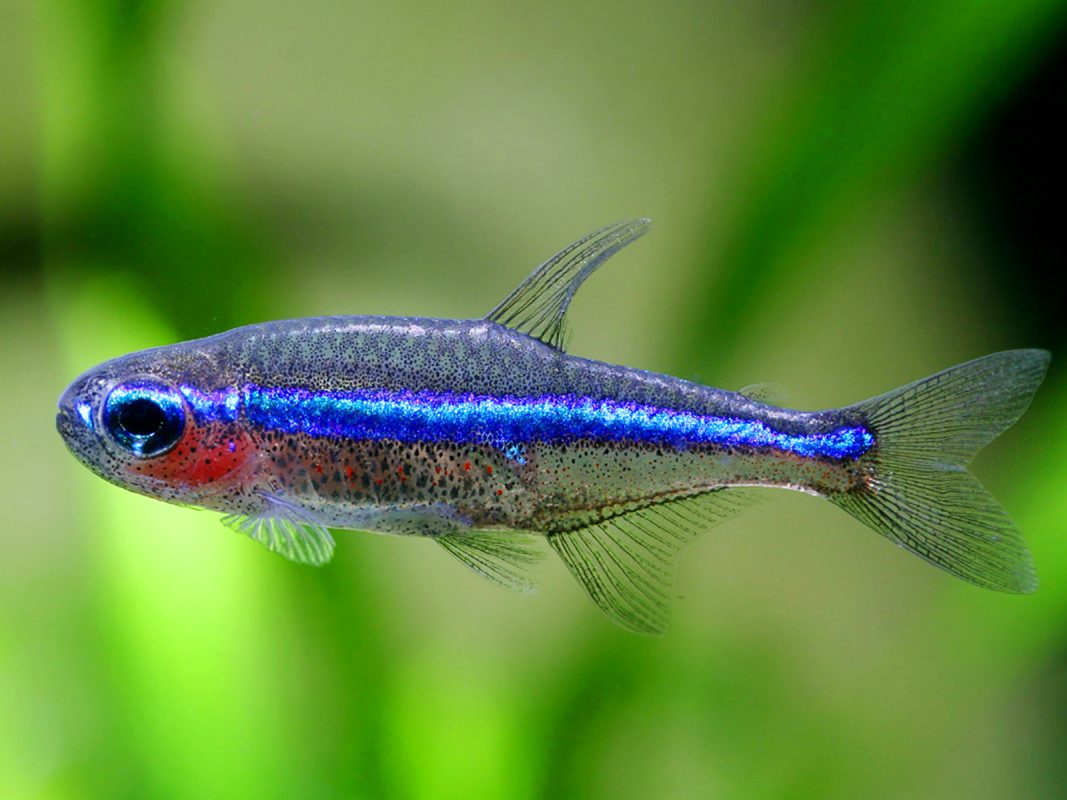Blogs
Paracheirodon simulans | The Enigmatic Green Neon Tetra
Nestled within the emerald depths of the Amazon basin, the Paracheirodon simulans, also known as the Green Neon Tetra, emerges as a captivating aquatic gem. Often mistaken for its close relative, the cardinal tetra, the green neon tetra distinguishes itself with its vibrant iridescent green-blue coloration and a subtle black stripe running horizontally along its body.
This captivating species, a member of the characin family, inhabits the blackwater tributaries of the Amazon. Their natural habitat consists of slow-moving, acidic waters stained a rich brown by tannins and humic substances. Submerged branches, leaf litter, and dense vegetation provide shelter and camouflage, creating a haven for these shy and social creatures.
Taxonomy and Scientific Classification
- Kingdom: Animalia
- Phylum: Chordata
- Class: Actinopterygii
- Order: Characiformes
- Family: Characidae
- Genus: Paracheirodon
- Species: Paracheirodon simulans
Habitat and Distribution
The Green Neon Tetra hails from the middle-to-upper rio Negro drainage in Brazil and the Río Orinoco system in Venezuela and Colombia. Their exclusive presence in blackwater environments highlights their sensitivity to water chemistry and preference for specific ecological conditions.
Physical Description
The Green Neon Tetra flaunts an elongated, laterally compressed body, reaching a maximum size of inches (3 cm). The most striking feature is the iridescent green-blue coloration that shimmers along their flanks, fading to a silvery white on the underside. A thin black stripe, running from the eye to the base of the caudal fin, provides a striking contrast. The dorsal fin boasts a reddish hue, while the remaining fins showcase a translucent quality.
Lifespan and Behavior
With proper care, these captivating fish boast an average lifespan of 3-5 years. Green Neon Tetras are gregarious by nature, thriving in groups of 6-8 individuals. In their natural habitat, they exhibit fascinating schooling behavior, believed to serve as a defense mechanism against predators.
They are peaceful and shy, making them compatible with other non-aggressive species. Ideal tank mates include neon tetras, rummy-nose tetras, and other small, community fish. However, keeping them with larger or aggressive fish should be avoided as they may become stressed or fall prey to predation.
Diet and Nutrition
Green Neon Tetras are omnivorous and exhibit a diverse diet in their natural environment. A balanced aquarium diet should include:
- High-quality flake or pellet food: These provide the foundation of their diet, ensuring essential nutrients.
- Live or frozen food: Brine shrimp, daphnia, and bloodworms offer vital protein and enhance their natural foraging instincts.
- Vegetable matter: Blanched spinach or algae wafers can supplement their diet with necessary vitamins and minerals.
Variety is key to ensure proper growth and vibrant coloration. Offer small amounts of food multiple times a day to prevent overfeeding and maintain water quality.
Water Parameters and Aquarium Setup
Replicating their natural habitat is crucial for keeping Green Neon Tetras healthy and thriving. Aim for the following tank conditions:
- Tank size: Minimum 10 gallons for a small group, with larger tanks preferred for larger groups.
- Temperature: 72-82°F (22-28°C)
- pH: 5.0-7.0
- Hardness: 1-5 dGH
- Substrate: Fine gravel or sand
- Filtration: Efficient filtration system for maintaining water quality
- Lighting: Dim or subdued lighting
- Décor: Dense vegetation (live or artificial), driftwood, leaf litter
Regular water changes (20-30% weekly) and good water circulation are essential to maintain optimal water quality.
Breeding and Propagation
Breeding Green Neon Tetras in captivity requires specific conditions and expertise. A separate breeding tank with soft, acidic water and fine-leaved plants is recommended. Encouraging spawning can involve simulating seasonal changes with temperature fluctuations and increased live food offerings. However, breeding success rates can be variable and require consistent monitoring and adjustments.
Common Diseases and Health Concerns
Like any fish, Green Neon Tetras are susceptible to certain diseases, including:
- Ichthyophthirius multifiliis (Ich): White spot disease, characterized by white spots on the body and fins.
- Fungal infections: Cotton-like growth on the body or fins.
- Fin rot: Decaying or ragged fins.
Maintaining a clean aquarium, providing a balanced diet, and minimizing stress are crucial for preventing diseases. Early detection and swift treatment are essential for successful management.
Conclusion
The Green Neon Tetra captivates hobbyists with its stunning coloration and peaceful nature. By understanding their specific habitat requirements, dietary needs, and social behavior, you can successfully create a thriving aquarium environment. While breeding presents a challenge, providing pristine water conditions and simulating natural spawning triggers can be rewarding. Whether you’re a seasoned aquarist or a curious beginner, the Green Neon Tetra offers a mesmerizing glimpse into the vibrant world of Amazonian biodiversity.
Frequently Asked Questions (FAQs)
1. Do Green Neon Tetras need to be kept in a school?
Yes, Green Neon Tetras are social fish and should be kept in groups of at least 6-8 individuals to reduce stress and promote natural behavior.
2. Can I keep Green Neon Tetras with other fish?
Yes, they are compatible with other peaceful and non-aggressive fish species, such as neon tetras, rummy-nose tetras, and small corydoras catfish. Avoid keeping them with larger or aggressive fish that may harass or prey on them.
3. How often should I feed Green Neon Tetras?
Feed them small amounts of food multiple times a day to prevent overfeeding and maintain water quality. A varied diet of high-quality flakes or pellets, live or frozen food, and occasional vegetable matter is recommended.
4. How can I tell if my Green Neon Tetra is healthy?
Healthy Green Neon Tetras will have a vibrant coloration, active behavior, and clear eyes and fins. Watch for any signs of disease, such as white spots, lethargy, or loss of appetite.
5. Where can I find more information about Green Neon Tetras?
Online fishkeeping forums, reputable websites, and books dedicated to tropical fish can provide further in-depth information about Green Neon Tetras and their care requirements.

